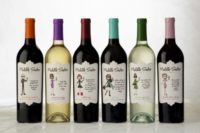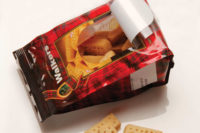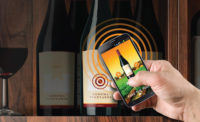Materials Technology: Labels
A look behind the label
Label technology drives branding, sharing and sustainability.

Coca-Cola’s “Share a Coke” campaign called for creative solutions from HP to print a variety of custom labels.

Modern technology offered up unique, vintage looks for two new Guinness brews.

The expanded CleanFlake portfolio from Avery Dennison will continue to improve rPET yield.



In many cases a product’s label provides the good’s primary marketing. When consumers encounter a product on shelves, the package or label are called upon to offer all of the information they could want. Consumers gravitate toward interesting and eye-catching labels, but it doesn’t stop there. Many consumers and most packagers also want labels to be more sustainable. Whether connecting consumers to a brand or easing environmental impact, label innovations are displaying new potential.
One of the most recognizable labels of this past year is the Coca-Cola “Share a Coke” label. Coke bottles were released with more than 250 names, nicknames and terms of endearment. The company wanted to provide a large range of names to help bring people together.
“Coca-Cola has been bringing people together for 128 years to create moments of happiness,” says Stuart Kronauge, SVP, Sparkling Brands, Coca-Cola North America. “Moments of happiness can define our lives. They can be grand or intimate, shared or personal, fleeting or even unassuming at times. We hope ‘Share a Coke’ creates occasions between people…where they can simply enjoy the moment.”
However, bringing personal connections to such a wide range of consumers can be difficult—in fact, it sounds nearly impossible. The variety of labels presented a unique challenge to HP (hp.com) who printed them for the beverage leader.
“‘Share a Coke’ would not be possible without digital printing, and it gave Coca-Cola the unique ability to engage in one-to-one communication with customers,” says Scott Biondich, group director, Sparkling Packaging and R&D Equipment Development, Coca-Cola North America. “Label production for this highly complex campaign required meticulous attention to variable data, consistent productivity and flawless color management. HP Indigo was the clear choice because of its proven print quality, productivity and strong global network.”
The labels used a new substrate and a laminate construction to help them stand up to the speed of bottling lines. Coca-Cola’s red ink had to be reformulated to work with the new substrate and HP had to maintain color consistency to uphold Coca-Cola’s standards. HP Indigo WS6000 series Digital Presses ran 24-hours a day, six days a week for around three months to meet the production minimums for enough “shareable” labels.
Coca-Cola isn’t the only company capitalizing on the connection their branding brings with it. Popular stout brewer, Guinness, has released two new porters as part of “The Brewers Project,” which allows brewers to explore new recipes and reinterpret old ones. To give these beers a feel that is both vintage and modern, Guinness owner, Diageo, worked with Contantia Flexibles – Label Group (cflex.com). The labels were printed on a pressure sensitive, paper substrate that features the trademark harp. Paper substrates are becoming more popular because they offer a natural, craft look. To bring the vintage feel to the new labels, they were finished with a matte varnish. The labels for each brew were cut into different shapes to indicate their heritage and distinct tastes.
Looks are important, but they don’t last forever, which Avery Dennison Label and Packaging Materials (label.averydennison.com) knows to also be true of the environment. This is why they have expanded their portfolio of CleanFlake label materials to include roll-fed shrink (RFS) sleeve labels for beverage containers and other PET applications, which improve PET yield for recyclers.
“We are excited about the expansion of this portfolio to include roll-fed shrink sleeve materials,” says Laura Clark, global marketing director for the beverage segment with Avery Dennison Label and Packaging Materials. “We believe that after winning eight industry sustainability awards, the CleanFlake portfolio is making an impact not only on the environment, but also in the marketplace.”
CleanFlake RFS is a low-density, machine-oriented shrink film. As the name suggests, it separates cleanly from the PET flakes created in the recycling process resulting in higher yields of food-grade recycled PET.
Labels offer more than good looks. They can communicate brand values, bring people together and build a better future.
Looking for a reprint of this article?
From high-res PDFs to custom plaques, order your copy today!










